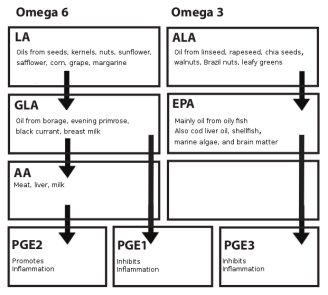The health benefits of fish oil
- and the huge difference between the omega-3 forms ALA, EPA, and DHA
 Most people lack omega-3 fatty acids acids that are vital for the brain, the nervous system, and the cardiovascular system. Omega-3 fatty acids also have anti-inflammatory and cancer-fighting properties. It is important to consume omega-3 and omega-6 fatty acids in the right balance in order to benefit from their many health effects. But how do we make sure to get enough omega-3 fatty acids that we can utilize? And what is the difference between ALA, EPA, and DHA?
Most people lack omega-3 fatty acids acids that are vital for the brain, the nervous system, and the cardiovascular system. Omega-3 fatty acids also have anti-inflammatory and cancer-fighting properties. It is important to consume omega-3 and omega-6 fatty acids in the right balance in order to benefit from their many health effects. But how do we make sure to get enough omega-3 fatty acids that we can utilize? And what is the difference between ALA, EPA, and DHA?
Like omega-6 fatty acids and cholesterol, omega-3 fatty acids are constituents of all cell membranes and take part in numerous biochemical processes. According to cell biologist Bruce Lipton, the cell membrane is the “command center” off the cell and determines how the cell works, and what genes that need to be activated. It is therefore vital to get enough omega-3 and omega-6 fatty acids and to ingest them in the proper balance. Nonetheless, most people today get far too little omega-3, or they consume a form of omega-3 that the body cannot utilize. It is therefore a good idea to look close at the different types of omega-3 and their functions in the body. The tables below give a useful overview.
Lack of enzymes makes it difficult to convert ALA into EPA and DHA
The type of omega-3 that is called ALA (alpha-linolenic acid) is essential, in that we humans are unable to synthesize it in the body. ALA is found in various vegetable food sources such as linseed oil, and there is also a limited amount of ALA in rapeseed oil, chia seeds, Brazil nuts, and walnuts.
ALA provides energy and is a precursor of the other omega-3 fatty acids, where EPA and DHA support various structural and biochemical processes.
Helped by enzymes, ALA gets converted into EPA (eicosapentaenoic acid), and EPA is then converted into DHA (docosahexaenoic acid) and into a type of hormone-like compounds known as prostaglandins (PGE3) that inhibit inflammation
The conversion of ALA to EPA and DHA is often limited because certain enzymes are missing. Studies suggest that only a limited amount of ALA that is consumed (typically 0.2 – 1%) gets converted into EPA and DHA.
Most people benefit more from fish oil
Although linseed oil contains 54% omega-3 in the form of ALA, only a limited amount is converted into EPA and DHA. Most people benefit far more from consuming EPA and DHA directly, especially from good sources such as oily fish (herring, anchovies, salmon, and mackerel), shellfish, and even fish oil supplements. At our latitude, people have been getting most of their omega-3 from fish and shellfish ever since the Stone Age. During this period, all villages were located by coasts, lakes, or streams that were full of fish and shellfish. The majority of studies conducted with omega-3 fatty acids is even based on oily fish and fish oil supplements.
Natural sources of various omega-3 fatty acids
ALA (alpha-linolenic acid): Linseed oil and smaller amounts in rapeseed oil, chia seeds, walnuts, Brazil nuts, and leafy greens.
EPA (eicosapentaenoic acid): Oily fish such as herring, mackerel, anchovies, and salmon, shellfish, cod liver oil, and the brain matter from fish and slaughter animals. Small amounts are synthesized from ALA.
DHA (docosahexaenoic acid): Oily fish such as herring, mackerel, anchovies, and salmon, shellfish, cod liver oil, and the brain matter from fish and slaughter animals. DHA is also made from EPA.
Natural sources of various omega-3 fatty acids
LA (linoleic acid): Most plant oils, margarine, nuts, kernels, and seeds
GLA (gamma-linolenic acid): Oil from borage, evening primrose, black currant, and breast milk. GLA is also made from LA.
DGLA (dihomo-gamma-linolenic acid). Organ meat (spleen, kidneys etc.) and breast milk. DGLA is also made from GLA.
AA (arachidonic acid): Meat, liver, and dairy products. AA is also made from DGLA.
The important balance and the competition between omega-3 and omega-6 fatty acids
Omega-3 fatty acids have an intricate biochemical interaction with omega-6 fatty acids. Here, the balance between the various types is enormously important. For instance, the omega-3 fatty acid EPA and the omega-6 fatty acid AA (arachidonic acid) are in direct competition about producing the different prostaglandins that control inflammation, insulin production, ovulation, labor contractions, and other processes in the body. Too little omega-3 and too much omega-6 may therefore set the stage for a number of diseases and health complaints that are common today.
EPA lowers inflammation, which is involved in most diseases
Modern diets contribute to the development of chronic inflammation, a problem that plays a significant role in muscle and joint pain, rheumatism and other autoimmune diseases, skin problems, allergies, neurological diseases, and possibly even overweight and cancer.
Mild, insidious inflammation is a problem in lifestyle diseases such as atherosclerosis, insulin resistance, and metabolic syndrome – an early stage of type-2 diabetes. In such cases, the omega-3 fatty acids help to control inflammation, provided we consume adequate amounts and a type of omega-3 that we can easily utilize. It is mainly EPA that prevents the omega-6 fatty acid, AA (arachidonic acid), from producing pro-inflammatory prostaglandins (PGE2). More specifically, EPA works by blocking an enzyme called D5D (delta-5-desaturase) that both EPA and AA use in their synthesis. Too little EPA results in an overproduction of AA (by means of D5D), and AA is the omega-6 fatty acid that is known to cause inflammation.
In other words, the more EPA we get from our diet, the more effectively we can prevent and fight inflammation, simply by inhibiting the production of AA. EPA even stimulates the PGE3 prostaglandins that have anti-inflammatory properties.
Not only does EPA inhibit inflammation by means of the prostaglandin synthesis, it also inhibits inflammatory cytokines, which are important signaling proteins of the immune system. Therapeutic treatments for inflammation such as aching joints and rheumatism normally calls for doses of around 1,000 mg of EPA.
- EPA prevents the D5D enzyme (delta-5-desaturase) from making AA
- The more EPA we get from our diet, the less AA we produce
- When sufficient amounts of EPA effectively block the production of AA, it is possible to obtain many of the same advantages as seen with corticosteroids such as prednisolone – but without the side effects
Simplified overview of the prostaglandin synthesis
|
Did you know that the brain contains large amounts of omega-3 and omega-6, and that the balance between these fatty acids is vital for our nervous system and mental health?
Depression and many neurological ailments are caused by inflammation in the brain
The brain of animals and humans contain large amounts of omega-3 and omega-6 that are important for the development of the brain and nervous system, and which provide integrity to the neurological network. The brain contains larger quantities of DHA and somewhat smaller quantities of EPA, but this does not mean that EPA plays a less significant role. EPA counteracts inflammation in the nervous system by competing against AA. The only way to prevent and reduce inflammation in the brain is by maintaining high blood levels of EPA. This explains why EPA has a greater effect than DHA in most of the studies that deal with depression, ADHD, and other neurological disorders where inflammation may be part of the picture.
EPA reduces cramps and menstrual pain
EPA can reduce cramps and menstrual pain by blocking the D5D enzyme and by promoting the anti-inflammatory PGE3 prostaglandins.
Bente Deutch from Århus University in Denmark headed a study of 78 younger women with dysmenorrhea (painful periods) and found that supplementing with two capsules of highly concentrated (65% omega-3) fish oil in the form of free fatty acids combined with vitamin B12 effectively reduced menstrual pain and abdominal discomfort.
|
Important note: It normally takes a month or more for a fish oil supplement or a diet with fish to work optimally. Once you discontinue, it takes a month or so for the positive effect to stop. |
DHA is particularly imporatnt for the brain, mood, IQ, and cardiovascular system
DHA regulates a type of enzyme activity known as NOS (nitric oxide synthase) that is important for our memory and learning skills. It is believed that the large human brain and its large content of DHA explains our high intelligence and superior ability to adapt. DHA helps control brain levels of serotonin, and scientists have found a connection between low DHA levels and conditions like depression, ADHD, and Alzheimer’s disease. Studies suggest that the combination of DHA and EPA may help treat these diseases.
The cardiovascular system
Both DHA and EPA are able to lower levels of triglycerides in the blood, thereby reducing the risk of cardiovascular disease. As mentioned earlier, EPA counteracts inflammation that is a major cause of atherosclerosis. Other than that, fish oil helps make cells and blood vessels more pliable.
The fatty acids in cell membranes are vital to our health
Our body consists of approximately 1013 (that is 10 followed by 13 zeros). All cells have a membrane that contains various lipids and proteins that protect the cell, absorb signals, and carry substances into and out of the cell.
The most important lipids are the phospholipids and cholesterol. Phospholipids are bound to various omega-3 and omega-6 fatty acids that either stimulate or inhibit numerous functions, depending on which cell type the fatty acids are hooked up with. Brain cells, retinal cells, and sperm cells have the highest quantity of DHA linked to their phospholipids and are therefore the type of cells that are most dependent on this specific omega-3 fatty acid.
Because DHA is a long-chained fatty acid compared with ALA and DPA, DHA takes up more space in the cell membrane, causing it to become less pliable and flexible. The pliability and flexibility of a cell membrane is vital for its ability to perform. One of the dominating theories about cell membrane functionality is even dubbed the ”fluid mosaic model” and describes the importance of a living, flexible cell membrane for the health and functionality of the cell. The more flexible the cell membrane is, the faster proteins are able to move and work in the membrane. This is why scientists like Bruce Lipton think of the cell membrane as the “brain of the cell” because proteins and other signals from the cell membrane activate and control various genes and functions inside the cell.
With too few polyunsaturated fatty acids such as EPA and DHA in particular, the cell membrane becomes stiff and inflexible and fails to function properly. This is what is observed in many brain and eye diseases, and possibly even with poor sperm quality.
Cancer
It is believed that DHA in combination with LDL cholesterol makes the cell membrane stronger and more resistant. This even increases the cell’s ability to function properly and prevent the onset of cellular changes and cancer.
EPA also helps to prevent cancer by inhibiting inflammation that is involved in several cancer forms.
Laboratory and animal studies show that EPA/DHA stops breast cancer and prostate cancer cells from spreading.
Content in omega-3 in grams (per 100 gram) |
|
| Linseed oil | 54 (ALA) |
| Rapeseed oil | 9 (ALA) |
| Walnut | 7 (ALA) |
| Cod liver oil | 21 (EPA/DHA) |
| Wild salmon, mackerel, and herring | 3-6 (EPA/DHA) |
We eat too little omega-3 and oily fish
Health authorities normally only recommend omega-3 as an important ingredient in a healthy, balanced diet. However, most people fail to adhere to the dietary guidelines, and many people shy away from the most significant sources, which are fish and shellfish.
International experts recommend:
- 500 mg (EPA/DHA) to prevent a deficiency
- 1 gram (EPA/DHA) for proactive support of e.g. the brain and cardiovascular system
- 2-4 grams (EPA/DHA) for intensive support of e.g. aching joints and for anti-inflammatory action (especially EPA)
Supplement quality and content of EPA and DHA
Fish oil supplement normally declare their content of EPA and DHA per capsule or daily dose. Fish oil supplements based on free fatty acids have good absorption. It is important to make sure that fish oil supplements comply with government requirements in terms of peroxide values and maximum content of environmental toxins.
Choose fish from the lower part of the food chainFish often contain mercury and other environmental toxins. Therefore, it is normally recommended to choose fish from the lower part of the food chain. Health authorities specifically warn pregnant women to limit their intake of tuna and other predatory fish, whereas there are often no warnings regarding salmon and smaller fish. A good idea is to avoid salmon from the Baltic Sea, as they may contain larger quantities of heavy metals and other toxins. Instead, stick with organic salmon or fish oil supplements. |
References
Barry Sears. What Are the Real Differences Between EPA and DHA?
http://www.zonediet.com/blog/what-are-the-real-differences-between-epa-and-dha/
Philip C. Calder Omega-3 Fatty Acids and Inflammatory Processes. Nutrients 2010
https://www.ncbi.nlm.nih.gov/pmc/articles/PMC3257651/
Bente Deutch et al: Menstrual discomfort in Danish women reduced by dietary supplements of omega-3 PUFA and B12 (fish oil or seal oil) Nutrition Research
http://news.emory.edu/stories/2015/04/rapaport_omega3_depression/index.html
https://da.wikipedia.org/wiki/Docosahexaensyre
Bruce Lipton. Intelligente celler. Borgen 2009
Olle Haglund. Omega-3-revolutionen. Medhag AB 2012
Search for more information...
- Created on .










 "After about one week of taking the Q10 supplement I could feel a huge difference," says 23-year old Alan Piccini, who has been suffering from extreme fatigue and muscle aches ever since he was a child.
"After about one week of taking the Q10 supplement I could feel a huge difference," says 23-year old Alan Piccini, who has been suffering from extreme fatigue and muscle aches ever since he was a child. “Taking capsules with co-enzyme Q10 has freed me of the severe side effects of my cholesterol lowering medicine,” Mrs Franken explains.
“Taking capsules with co-enzyme Q10 has freed me of the severe side effects of my cholesterol lowering medicine,” Mrs Franken explains.